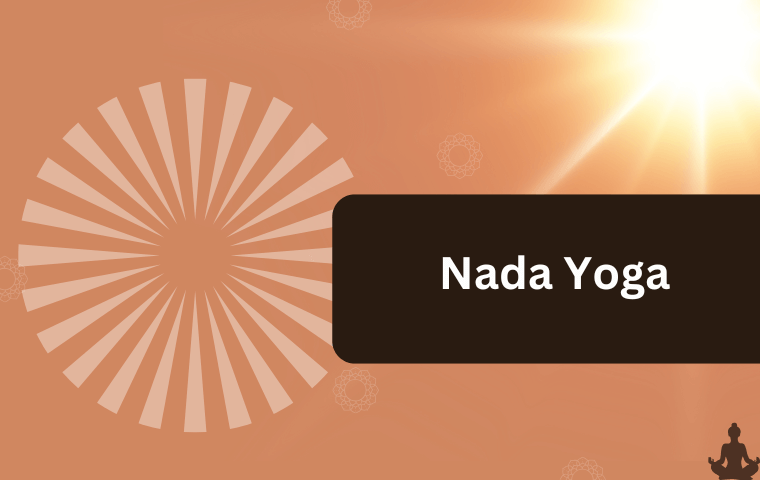Nada Yoga is the practice of connecting with the sounds that exist all around us and within us to achieve a higher state of consciousness and inner harmony. The word “Nada” means sound, and “Yoga” means union. So, this yoga is about the union of the mind with the cosmic sounds that shape our universe.
In simple terms, Nada Yoga is a form of meditation that uses sound. It involves listening to and harmonizing with the vibrations that we hear in the world, the body, and the universe. These sounds can be both physical, like the sound produced by striking objects (Ahat Nada), and subtle, like the sounds inside the body (Anahat Nada). Anahat Nada, often associated with the sound of “Aum,” represents the primal sound that exists in the universe and gives rise to all other sounds.
The Healing Power of Sound

Nada Yoga has significant benefits for mental, physical, and emotional health. By tuning into these sounds, we can reduce stress, anxiety, and emotional imbalances. This practice helps us reconnect with our inner vibrations and align them with the natural rhythm of the universe. Just as a broken instrument can sound off-key, a mind or body out of tune with its natural vibrations can lead to discomfort, illness, or distress. This yoga restores balance by bringing the body, mind, and soul into harmony.
This practice helps clear mental clutter and reduce the stress that often interferes with our well-being. In today’s fast-paced world, we can easily disconnect from the natural flow of energy around us, making it especially useful to reconnect through Anahat Nada.
The Science Behind Nada Yoga
Sound is a vibration, and everything in the universe, whether it’s the Earth, stars, or even our bodies, has its unique vibration or sound. The ancient sages who practiced Nada Yoga understood that by tuning into these vibrations, they could access higher states of consciousness. By focusing on sound, they could harmonize their minds and bodies with the universal frequency.
One of the most powerful tools in this yoga is “Aum,” a sound considered sacred in many spiritual traditions. Aum is seen as the origin of all sounds in the universe. When practitioners of Nada Yoga meditate on Aum or other sacred sounds, they can attune their consciousness to the rhythm of the cosmos.
The Stages of Sound in Nada Yoga
In Nada Yoga, there are different types of sounds that practitioners focus on:

Baikhari (Audible Sound)
This is the physical sound, like the noise made when objects strike each other. This sound is easy to hear and is the starting point for many who practice sound healing or meditation.
Madhyama (Internal Sound)
This sound is subtle and can be heard inside the body. It includes the sounds of breathing, heartbeat, and circulation. When practitioners meditate, they focus on these internal sounds to bring balance to the mind and body.
Pashyanti (Mental Sound)
This is the mental sound that comes from deep within, closer to the mind than the ears. It is linked to intuition and can help the practitioner connect with higher states of awareness.
Para (Transcendental Sound)
This is the deepest form of sound, which cannot be heard by the ears. It represents the ultimate state of this yoga, where the practitioner reaches unity with the universe’s vibrations.
The Role of Music in Nada Yoga

Nada Yoga is deeply connected with music, especially in traditions like Indian classical music. Indian music aligns with the rhythms of nature, using specific ragas (melodies) to evoke different emotions and states of mind. For example, musicians play a raga during a particular season or time of day to create an emotional effect. Through Nada Yoga, practitioners see even the sounds of everyday life as an opportunity to connect with the universal flow.
Benefits of Nada Yoga
By practicing Nada Yoga, individuals can experience profound healing. The sound vibrations help clear blockages in the body’s energy system, resulting in better health, emotional balance, and spiritual growth. Some of the benefits include:

- Mental Peace: This yoga helps calm the mind, reduce stress, and bring clarity to thoughts.
- Physical Healing: The vibrations from sound can support physical healing by rebalancing the body’s energy.
- Emotional Balance: Listening to calming sounds helps let go of negative emotions, fostering a sense of tranquility and happiness.
- Spiritual Growth: Nada Yoga helps practitioners connect with higher consciousness and experience spiritual awakening.
Tuning Into Inner Peace
Nada Yoga is a powerful path to healing, personal growth, and spiritual enlightenment. It teaches us to listen deeply, harmonize with the world around us, and align ourselves with the universal flow of sound. Whether through the ancient sound of Aum or the rhythms of nature, Nada Yoga reminds us that sound is not just noise; it is the key to unlocking peace, health, and spiritual awakening.

